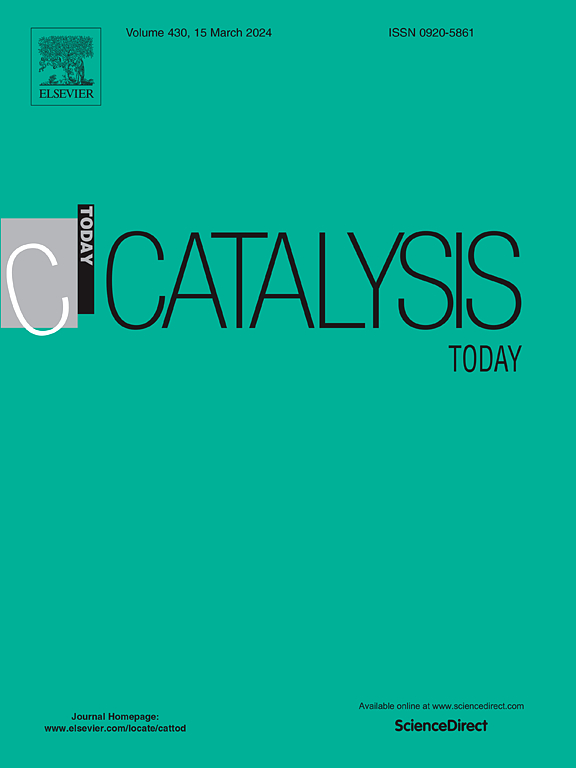Hydrodeoxygenation of guaiacol and anisole over alumina supported monometallic Ni and Cu catalysts: Studies on the effect of metal sites
IF 5.2
2区 化学
Q1 CHEMISTRY, APPLIED
引用次数: 0
Abstract
Valorization of lignin-derived phenolics by hydrodeoxygenation (HDO) poses two major challenges. The first one is the reduction of oxygen content and the second one is to prevent the loss of C atoms from the feedstock while removing oxygen atoms in, -OCH3 groups. In this study, Ni/Al2O3 catalysts were found to be efficient for deoxygenation, and Cu/Al2O3 catalysts were used to selectively carry out reactions intended toward preventing C losses. HDO over Ni/Al2O3 catalysts resulted in the hydrogenation of the aromatic ring of guaiacol and anisole, followed by demethoxylation, as the major reaction pathway. The demethoxylation reaction was favored at lower H2 pressure. However, at lower pressure catalytic deactivation and the nonlinear Arrhenius nature of the aromatic ring hydrogenation limited guaiacol and anisole conversions at higher temperatures. It was found that with the increase in Ni loading the overall conversion was maximum at 10 wt% Ni. Since the demethoxylation reaction occurred only after aromatic ring hydrogenation, its rate showed a similar dependence on both Ni loading and reaction temperature as that of hydrogenation. In this work, (de)methylation reactions of guaiacol and anisole were carried out selectively over Cu/Al2O3 catalysts. Adsorption studies showed that alumina sites were responsible for the reactive adsorption which gave rise to the (de)methylation reactions; and the Cu sites further enhanced these reactions, especially at higher H2 pressures. We have achieved about 65 % molar conversion of guaiacol selectively towards the formation of catechol, phenol, and methylated catechols/phenols, accompanied by small quantities of toluene and xylenes.
愈创木酚和苯甲醚在氧化铝负载的单金属Ni和Cu催化剂上的加氢脱氧:金属位影响的研究
木质素衍生的酚类化合物的氢脱氧(HDO)增值面临两个主要挑战。第一个是减少氧含量,第二个是在去除,-OCH3基团中的氧原子的同时防止原料中C原子的损失。在这项研究中,Ni/Al2O3催化剂被发现是有效的脱氧,而Cu/Al2O3催化剂被用来选择性地进行旨在防止C损失的反应。在Ni/Al2O3催化剂上的HDO反应以愈创木酚和苯甲醚的芳香环加氢为主要反应途径,其次是脱甲氧基化。较低的H2压力有利于脱甲氧基化反应。然而,在较低的压力下催化失活和芳香环加氢的非线性Arrhenius性质限制了愈创木酚和苯甲醚在较高温度下的转化。随着Ni含量的增加,总转化率在10 wt% Ni时达到最大值。由于脱甲氧基化反应只在芳环加氢后才发生,因此脱甲氧基化反应的速率与加氢反应的速率同样依赖于Ni负载和反应温度。在Cu/Al2O3催化剂上选择性地进行愈创木酚和苯甲醚的(去)甲基化反应。吸附研究表明,氧化铝位点负责反应性吸附,引起(去)甲基化反应;Cu位点进一步增强了这些反应,特别是在较高的H2压力下。我们已经实现了65%的愈创木酚选择性转化为儿茶酚,苯酚和甲基化儿茶酚/苯酚,伴随着少量的甲苯和二甲苯。
本文章由计算机程序翻译,如有差异,请以英文原文为准。
求助全文
约1分钟内获得全文
求助全文
来源期刊

Catalysis Today
化学-工程:化工
CiteScore
11.50
自引率
3.80%
发文量
573
审稿时长
2.9 months
期刊介绍:
Catalysis Today focuses on the rapid publication of original invited papers devoted to currently important topics in catalysis and related subjects. The journal only publishes special issues (Proposing a Catalysis Today Special Issue), each of which is supervised by Guest Editors who recruit individual papers and oversee the peer review process. Catalysis Today offers researchers in the field of catalysis in-depth overviews of topical issues.
Both fundamental and applied aspects of catalysis are covered. Subjects such as catalysis of immobilized organometallic and biocatalytic systems are welcome. Subjects related to catalysis such as experimental techniques, adsorption, process technology, synthesis, in situ characterization, computational, theoretical modeling, imaging and others are included if there is a clear relationship to catalysis.
 求助内容:
求助内容: 应助结果提醒方式:
应助结果提醒方式:


